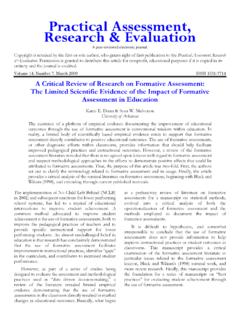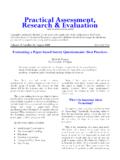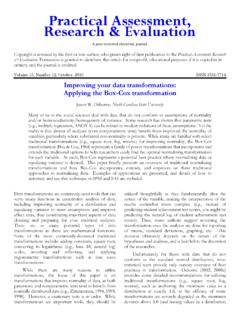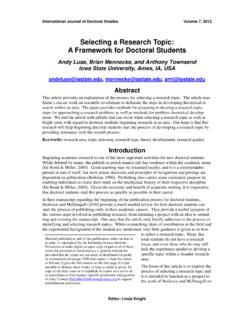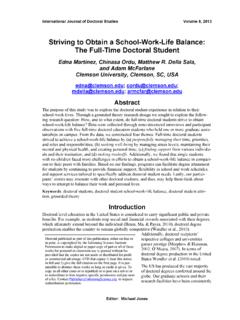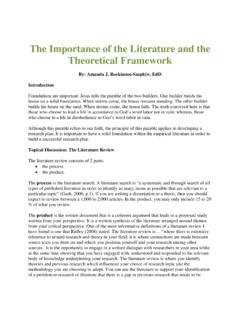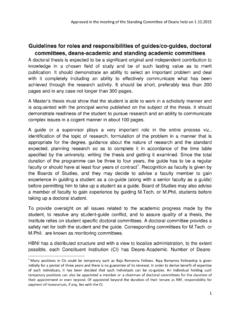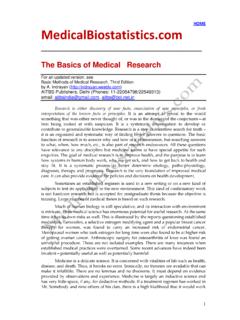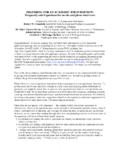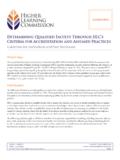Transcription of A Guide to Writing the Dissertation Literature Review
1 A peer-reviewed electronic journal. Copyright is retained by the first or sole author, who grants right of first publication to the Practical Assessment, research & Evaluation. Permission is granted to distribute this article for nonprofit, educational purposes if it is copied in its entirety and the journal is 14, Number 13, June 2009 ISSN 1531-7714 A Guide to Writing the Dissertation Literature Review Justus J. Randolph Walden University Writing a faulty Literature Review is one of many ways to derail a Dissertation . This article summarizes some pivotal information on how to write a high-quality Dissertation Literature Review . It begins with a discussion of the purposes of a Review , presents taxonomy of Literature reviews, and then discusses the steps in conducting a quantitative or qualitative Literature Review .
2 The article concludes with a discussion of common mistakes and a framework for the self-evaluation of a Literature Review . Writing a faulty Literature Review is one of many ways to derail a Dissertation . If the Literature Review is flawed, the remainder of the Dissertation may also be viewed as flawed, because a researcher cannot perform significant research without first understanding the Literature in the field (Boote & Beile, 2005, p. 3). Experienced thesis examiners know this. In a study of the practices of Australian Dissertation examiners, Mullins and Kiley (2002) found that, Examiners typically started reviewing a Dissertation with the expectation that it would pass; but a poorly conceptualized or written Literature Review often indicated for them that the rest of the Dissertation might have problems.
3 On encountering an inadequate Literature Review , examiners would proceed to look at the methods of data collection, the analysis, and the conclusions more carefully. (Boote & Beile, 2005, p. 6) Given the importance of Literature reviews in both dissertations and journal articles, it may be surprising that so many of them are faulty. Boote and Beile (2005) claim that the dirty secret known by those who sit on Dissertation committees is that most Literature reviews are poorly conceptualized and written (p. 4). Further, dissertations and theses are not the only types of publications that suffer from poor Literature reviews. Many Literature reviews in manuscripts submitted for publication in journals are also flawed see Alton-Lee (1998), Grante and Graue (1999), and LeCompte, Klinger, Campbell, and Menck (2003).
4 Given that so many Literature reviews are poorly done, it is surprising there is not more published information on how to write a Literature Review . Boot and Beile (2005) write, Doctoral students seeking advice on how to improve their Literature reviews will find little published guidance worth heeding.. Most graduate students receive little or no formal training in how to analyze and synthesize the research Literature in their field, and they are unlikely to find it elsewhere. (p. 5) Not only is there a lack of published information to Guide writers of Literature reviews, the labor intensive process of Writing one compounds the problem. Gall, Borg, and Gall (1996) estimate that completion of an acceptable Dissertation Literature Review will take between three and six months of effort.
5 The purpose of this Guide is to collect and summarize the most relevant information on how to write a Dissertation Literature Review . I begin with a discussion of the purposes of a Review , present Cooper s (1988) Taxonomy of Literature Reviews, and discuss the steps in conducting a quantitative or qualitative Literature Review . A discussion of common mistakes and a Practical Assessment, research & Evaluation, Vol 14, No 13 Page 2 Randolph, Dissertation Literature Review framework for the self-evaluation of Literature reviews concludes the article. Purposes for Writing a Literature Review Conducting a Literature Review is a means of demonstrating an author s knowledge about a particular field of study, including vocabulary, theories, key variables and phenomena, and its methods and history.
6 Conducting a Literature Review also informs the student of the influential researchers and research groups in the field. Finally, with some modification, the Literature Review is a legitimate and publishable scholarly document (LeCompte & colleagues, 2003, p. 124). Apart from the above reasons for Writing a Review ( , proof of knowledge, a publishable document, and the identification of a research family), the scientific reasons for conducting a Literature Review are many. Gall, Borg, and Gall (1996) argue that the Literature Review plays a role in: delimiting the research problem, seeking new lines of inquiry, avoiding fruitless approaches, gaining methodological insights, identifying recommendations for further research , and seeking support for grounded theory.
7 Hart (1998) contributes additional reasons for reviewing the Literature , including: distinguishing what has been done from what needs to be done, discovering important variables relevant to the topic, synthesizing and gaining a new perspective, identifying relationships between ideas and practices, establishing the context of the topic or problem, rationalizing the significance of the problem, enhancing and acquiring the subject vocabulary, understanding the structure of the subject, relating ideas and theory to applications, identifying the main methodologies and research techniques that have been used, and placing the research in a historical context to show familiarity with state-of-the-art developments. (p. 27) Another purpose for Writing a Literature Review not mentioned above is that it provides a framework for relating new findings to previous findings in the discussion section of a Dissertation .
8 Without establishing the state of the previous research , it is impossible to establish how the new research advances the previous research . Taxonomy of Literature Reviews An effective method to begin planning a research Review is to consider where the proposed Review fits into Cooper s (1988) Taxonomy of Literature Reviews. As shown in Table 1, Cooper suggests that Literature reviews can be classified according to five characteristics: focus, goal, perspective, coverage, organization, and audience. In Table 1, each characteristic is listed on the left, with the levels of the characteristics on the right. In the paragraphs that follow, each of these Literature Review characteristics are described in more detail. Focus The first characteristic is the focus of the Review .
9 Cooper (1988) identifies four potential foci: research outcomes, research methods, theories, or practices or applications. Literature reviews that focus on research outcomes are perhaps the most common. In fact, the Educational Resources Information Center (1982, p. 85) defines a Literature Review as an information analysis and synthesis, focusing on findings and not simply bibliographic citations, summarizing the substance of the Literature and drawing conclusions from it (italics mine). The Educational Resources Information Center suggests that, in terms of a developing a research rationale, an outcomes-oriented Review may help identify a lack of information on a particular research outcome, thus establishing a justifiable need for an outcome study.
10 Methodological reviews concentrate on research methods Cooper s second focus category. In a methodological Review , research methods in the chosen field are investigated to identify key variables, measures, and methods of analysis and inform outcomes-oriented research . The methodological Review is also helpful to identify methodological strengths and weaknesses in a body of research , and examine how research practices Practical Assessment, research & Evaluation, Vol 14, No 13 Page 3 Randolph, Dissertation Literature Review differ across groups, times, or settings. Methodological reviews, combined with outcome reviews, may also identify ways in which the methods inform the outcomes. A methodological Review may also lead to sound rationale that can justify proposed Dissertation research , if it turns out that the previous research has been methodologically flawed.

